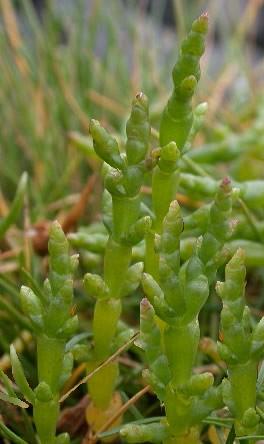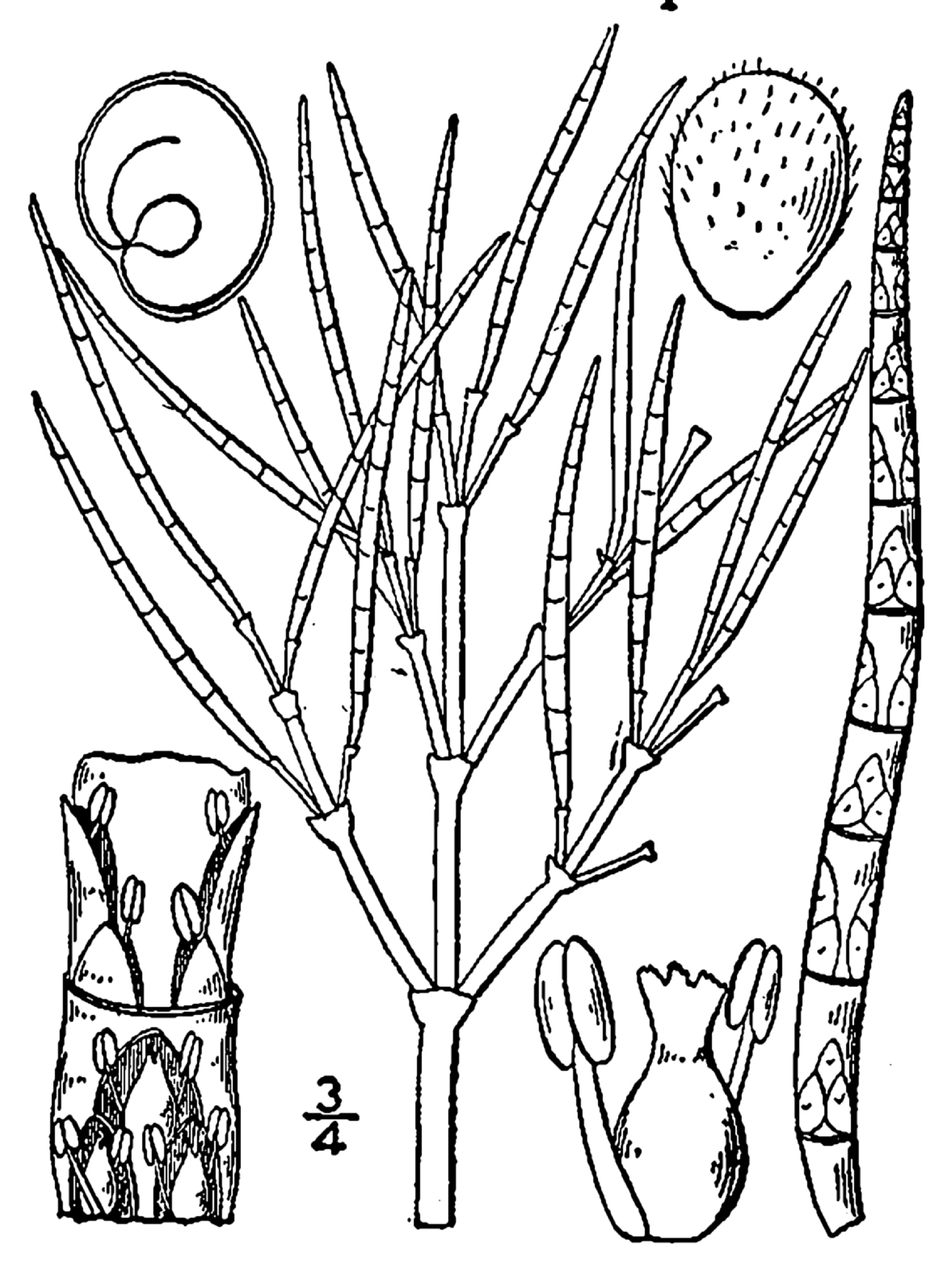|
Samphire
Samphire is a name given to a number of succulent salt-tolerant plants (halophytes) that tend to be associated with water bodies. *Rock samphire, ''Crithmum maritimum'' is a coastal species with white flowers that grows in Ireland, the United Kingdom and the Isle of Man. This is probably the species mentioned by Shakespeare in King Lear. *Golden samphire, ''Limbarda crithmoides'' is a coastal species with yellow flowers that grows across Eurasia. *Several species in the genus ''Salicornia'', known as "marsh samphire" in Britain. * ''Blutaparon vermiculare'', Central America, southeastern North America *''Tecticornia'', Australia *''Sarcocornia'', cosmopolitan Following the construction of the Channel Tunnel, the nature reserve created on new land near Folkestone made from excavated rock was named "Samphire Hoe". Etymology Originally "sampiere", a corruption of the French "Saint Pierre" (Saint Peter), samphire was named after the patron saint of fishermen because all of th ... [...More Info...] [...Related Items...] OR: [Wikipedia] [Google] [Baidu] |
Crithmum
''Crithmum'' is a monospecific genus of flowering plant in the carrot family Apiaceae, with the sole species ''Crithmum maritimum'', known as rock samphire, sea fennel or samphire. The name "samphire" is also used for several other unrelated succulent halophyte species of coastal plant. Sea fennel, or Rock samphire, is an edible wild plant. It is found on coastlines throughout much of Europe (north to the British Isles), Macaronesia, parts of West Asia and North Africa in the Atlantic, Mediterranean and Black Sea coasts. History, trade and cultivation In the 17th century, Shakespeare in ''King Lear'' referred to the dangerous practice of collecting rock samphire from cliffs. ''"Half-way down, Hangs one that gathers samphire; dreadful trade!"'' In the 19th century, samphire was being shipped in casks of seawater from the Isle of Wight to market in London at the end of May each year. Rock samphire used to be cried in London streets as "Crest Marine". In England, rock samph ... [...More Info...] [...Related Items...] OR: [Wikipedia] [Google] [Baidu] |
Crithmum Maritimum
''Crithmum'' is a monospecific genus of flowering plant in the carrot family Apiaceae, with the sole species ''Crithmum maritimum'', known as rock samphire, sea fennel or samphire. The name "samphire" is also used for several other unrelated succulent halophyte species of coastal plant. Sea fennel, or Rock samphire, is an edible wild plant. It is found on coastlines throughout much of Europe (north to the British Isles), Macaronesia, parts of West Asia and North Africa in the Atlantic, Mediterranean and Black Sea coasts. History, trade and cultivation In the 17th century, Shakespeare in ''King Lear'' referred to the dangerous practice of collecting rock samphire from cliffs. ''"Half-way down, Hangs one that gathers samphire; dreadful trade!"'' In the 19th century, samphire was being shipped in casks of seawater from the Isle of Wight to market in London at the end of May each year. Rock samphire used to be cried in London streets as "Crest Marine". In England, rock samph ... [...More Info...] [...Related Items...] OR: [Wikipedia] [Google] [Baidu] |
Salicornia
''Salicornia'' is a genus of succulent, halophytic (salt tolerant) flowering plants in the family Amaranthaceae that grow in salt marshes, on beaches, and among mangroves. ''Salicornia'' species are native to North America, Europe, Central Asia, and southern Africa. Common names for the genus include glasswort, pickleweed, picklegrass, and marsh samphire; these common names are also used for some species not in ''Salicornia''. To French speakers in Atlantic Canada, they are known colloquially as ''titines de souris'' ('mouse tits'). The main European species is often eaten, called marsh samphire in Britain, and the main North American species is occasionally sold in grocery stores or appears on restaurant menus as sea beans, samphire greens or sea asparagus. Description The ''Salicornia'' species are small annual herbs. They grow prostrate to erect, their simple or branched stems are succulent, hairless, and appear to be jointed. The opposite leaves are strongly reduced to sma ... [...More Info...] [...Related Items...] OR: [Wikipedia] [Google] [Baidu] |
Samphire Hoe Country Park
Samphire Hoe is a country park situated west of Dover in Kent in southeast England. The park was created by using 4.9 million cubic metres of chalk marl from the Channel Tunnel excavations and is found at the bottom of a section of the White Cliffs of Dover. The site is owned by Getlink, and managed by the White Cliffs Countryside Project. It is accessible by the public via a single-track tunnel controlled by traffic lights, which crosses over the South Eastern Main Line that is running in the Shakespeare Cliff tunnel underneath. Visitor facilities are provided, including car parking, toilets and a café. Origin of the name Samphire Hoe is named after the wild plant rock samphire that was once collected from the Dover cliffs; its fleshy green leaves were picked in May and pickled in barrels of brine and sent to London, where it was served as a dish to accompany meat. A 'hoe' is a piece of land which sticks out into the sea. The name was coined by Mrs Gillian Janaway, a retir ... [...More Info...] [...Related Items...] OR: [Wikipedia] [Google] [Baidu] |
Tecticornia
''Tecticornia'' is a genus of succulent, salt tolerant plants largely endemic to Australia. Taxa in the genus are commonly referred to as samphires. In 2007, the genus ''Halosarcia'', along with three other Australian genera (''Pachycornia'', ''Sclerostegia'' and ''Tegicornia'') was incorporated into the genus. Description The species of ''Tecticornia'' grow as annual or perennial herbs, subshrubs or small shrubs. Stems are branched, glabrous and appear jointed. The opposite leaves are fleshy, glabrous, connate in the lower part and cup-like or collar-like stem-clasping, with minute (0–3 mm long) two-lobed to triangular leaf blades. The spike-shaped inflorescences consist of opposite bracts, mostly connate and stem-clasping, free in some species. Their blades are cup- or collar-like or deltoid to semi-circular scales. In the axil of each bract, there are three to five (rarely one or seven) flowers, free or sometimes fused to each other, to the bract, and to the ... [...More Info...] [...Related Items...] OR: [Wikipedia] [Google] [Baidu] |
Golden Samphire
The golden samphire (''Limbarda crithmoides'') is a perennial coastal species, which may be found growing on salt marsh or sea cliffs across western and southern Europe and the Mediterranean. Golden samphire has a tufted habit, and the plant may grow up to 1 m tall. It has narrow fleshy green to yellow green leaves and large flower heads, with six yellow ray florets which may be up to across. The flowers are self-fertile (able to pollinate themselves) and may also be pollinated by bees, flies and beetles. They bloom between June and October and can smell like shoe polish.Chris Gibson Taxonomy It was first described by Carl Linnaeus as ''Inula crithmoides'' in his book 'Species Plantarum' 2 on page 883 in 1753 and then later when the genus was renamed, it was published as ''Limbarda crithmoides'' by Barthélemy Charles Joseph Dumortier in Fl. Belg. on page 68 in 1827. It was verified by United States Department of Agriculture and the Agricultural Research Service on 11 June 20 ... [...More Info...] [...Related Items...] OR: [Wikipedia] [Google] [Baidu] |
Glasswort
The glassworts are various succulent, annual halophytic plants, that is, plants that thrive in saline environments, such as seacoasts and salt marshes. The original English glasswort plants belong to the genus ''Salicornia'', but today the glassworts include halophyte plants from several genera, some of which are native to continents unknown to the medieval English, and growing in ecosystems, such as mangrove swamps, never envisioned when the term glasswort was coined. The common name "glasswort" came into use in the 16th century to describe plants growing in England whose ashes could be used for making soda-based (as opposed to potash-based) glass.Turner, William (1995). ''A New Herball: Parts II and III'', edited by George T. L. Chapman, Frank McCombie, and Anne U. Wesencraft (Cambridge University Press, ). This book contains a facsimile of Turner's original 1562 and 1568 volumes, along with an edited transcript. The transcript of Turner's article on Kali (p. 673) includes the ... [...More Info...] [...Related Items...] OR: [Wikipedia] [Google] [Baidu] |
Blutaparon Vermiculare
''Blutaparon vermiculare'', with common names silverhead, silverweed, saltweed, and samphire, is a species of plant in the family Amaranthaceae, native to Central America Central America ( es, América Central or ) is a subregion of the Americas. Its boundaries are defined as bordering the United States to the north, Colombia to the south, the Caribbean Sea to the east, and the Pacific Ocean to the west. ... and the southeastern United States. It is an edibleFlorida Ethnobotany by Daniel F. Austin, p 145 https://books.google.com/books/about/Florida_Ethnobotany.html?id=7qgPCEiI4WMC References Amaranthaceae {{Amaranthaceae-stub ... [...More Info...] [...Related Items...] OR: [Wikipedia] [Google] [Baidu] |




